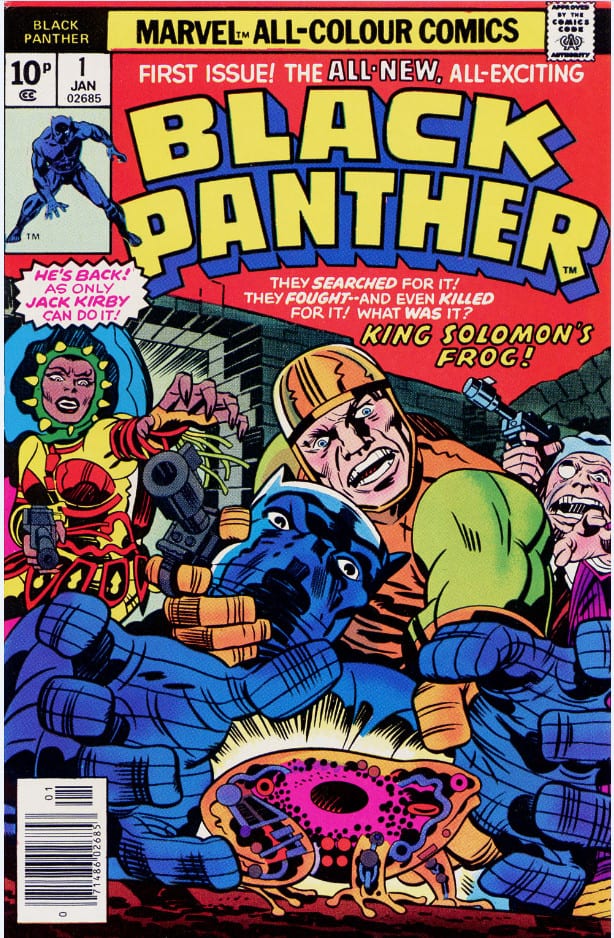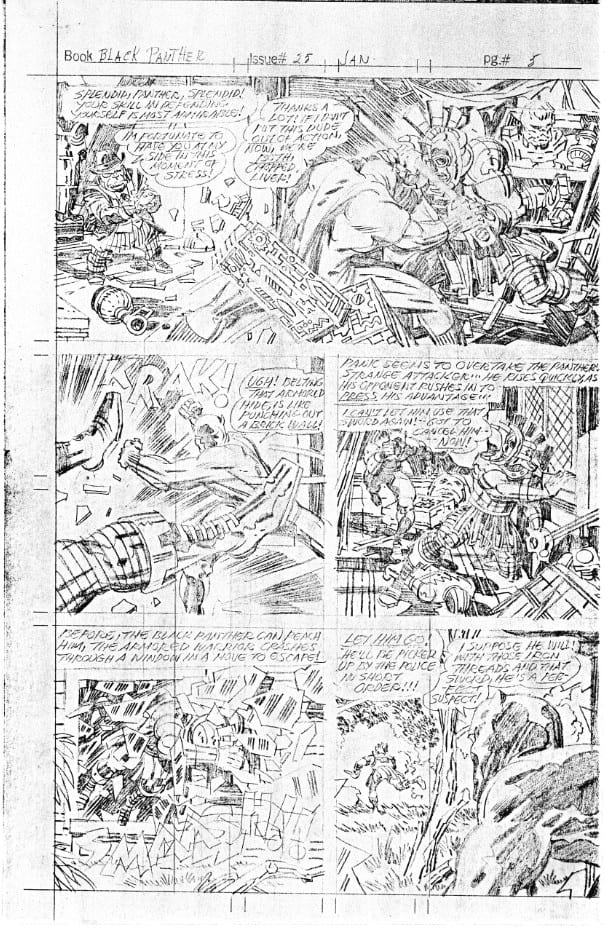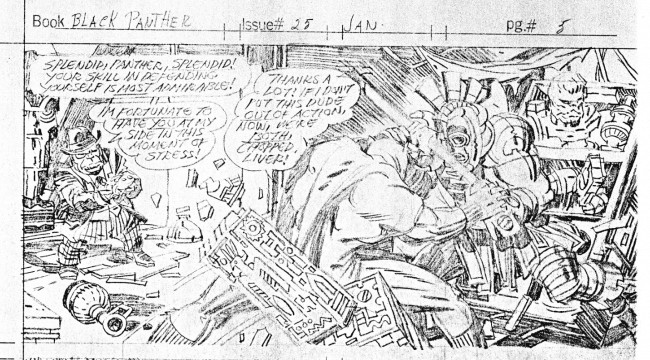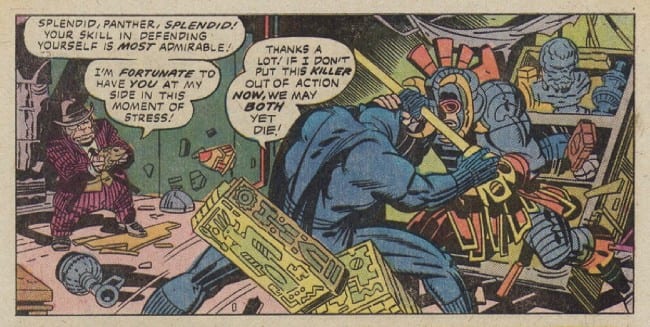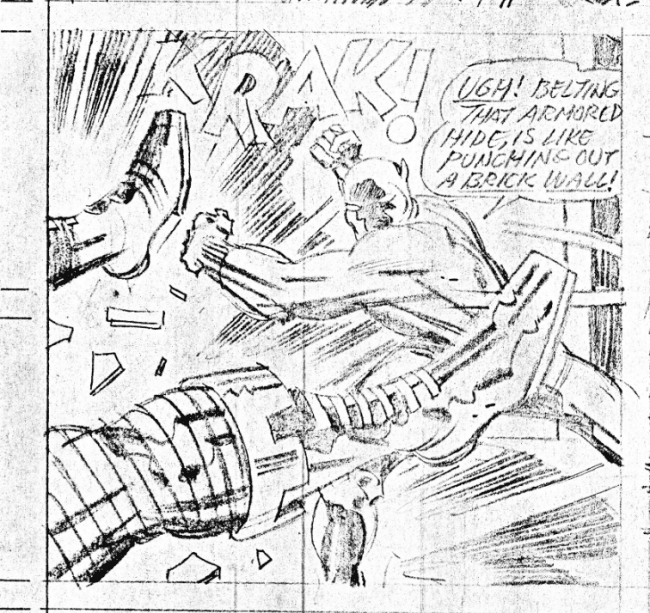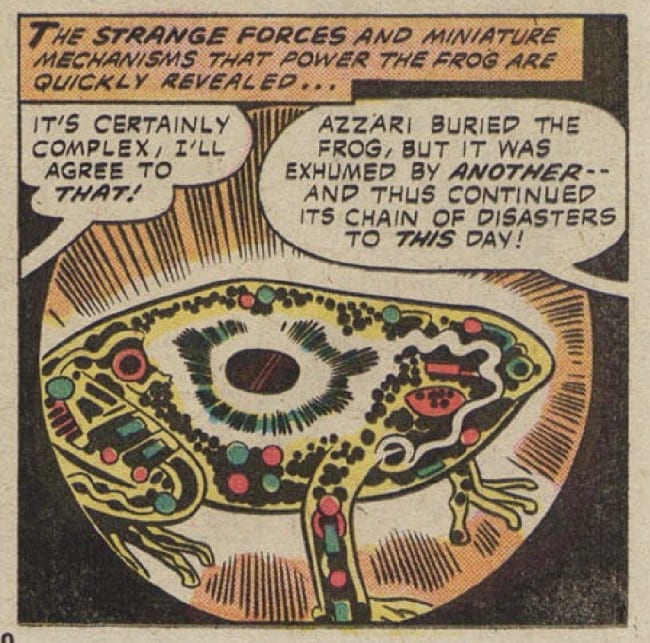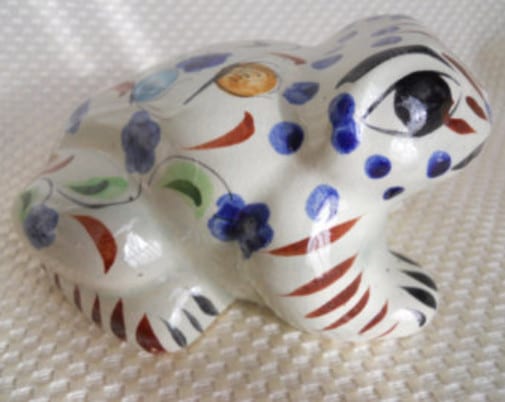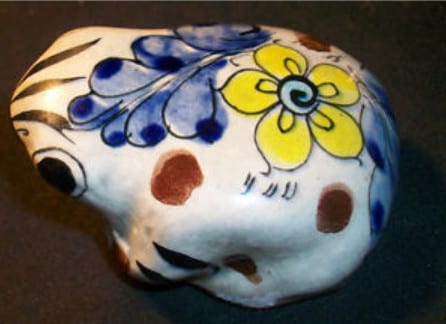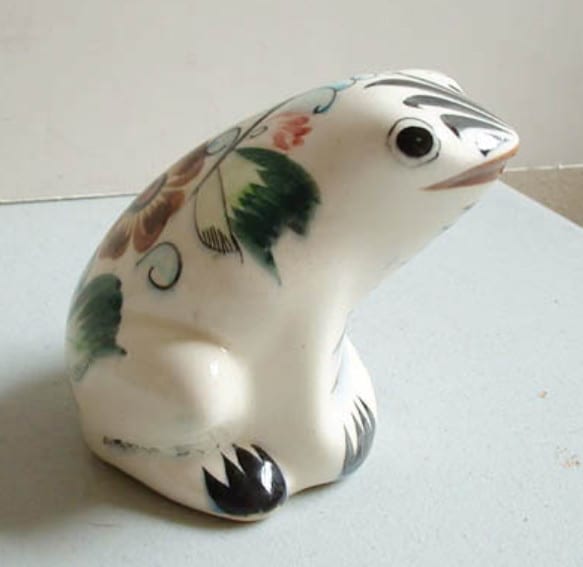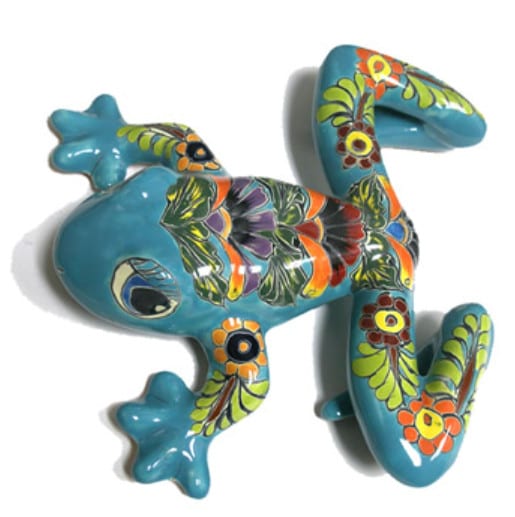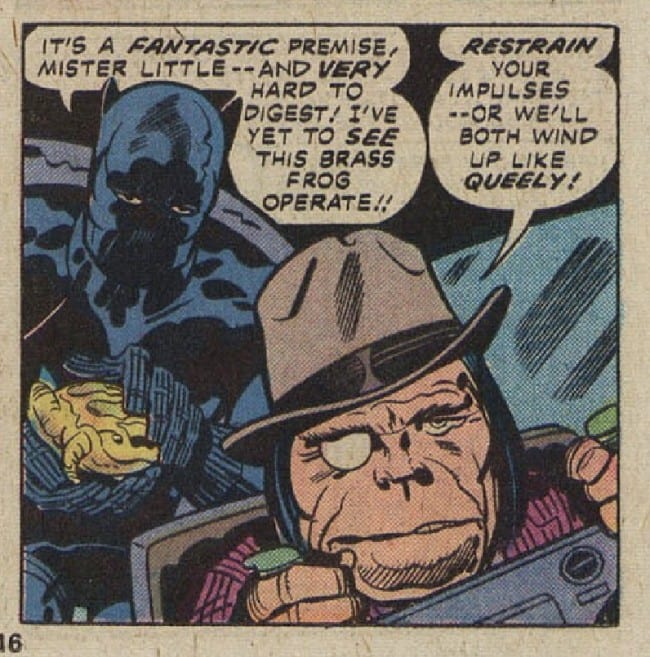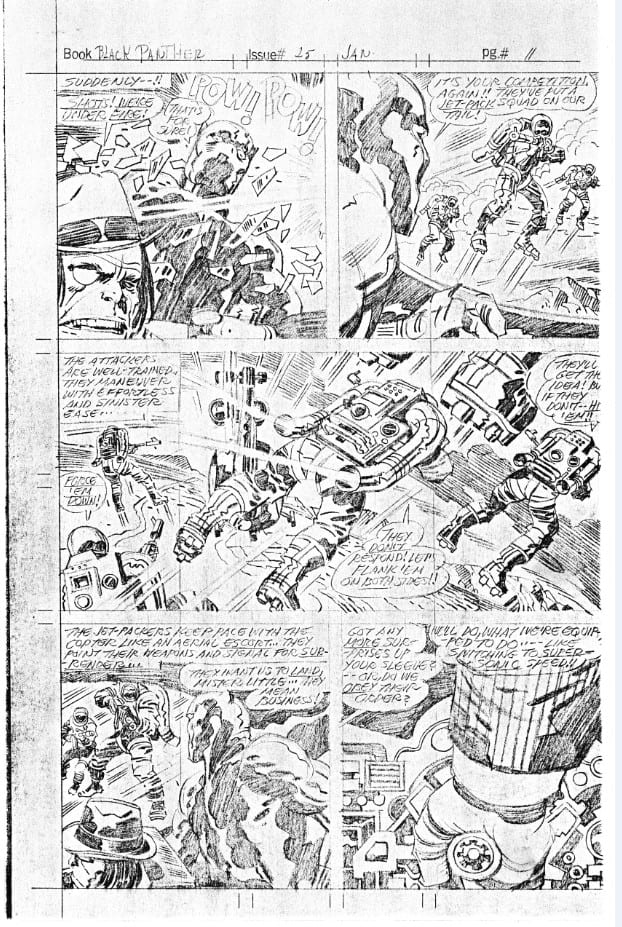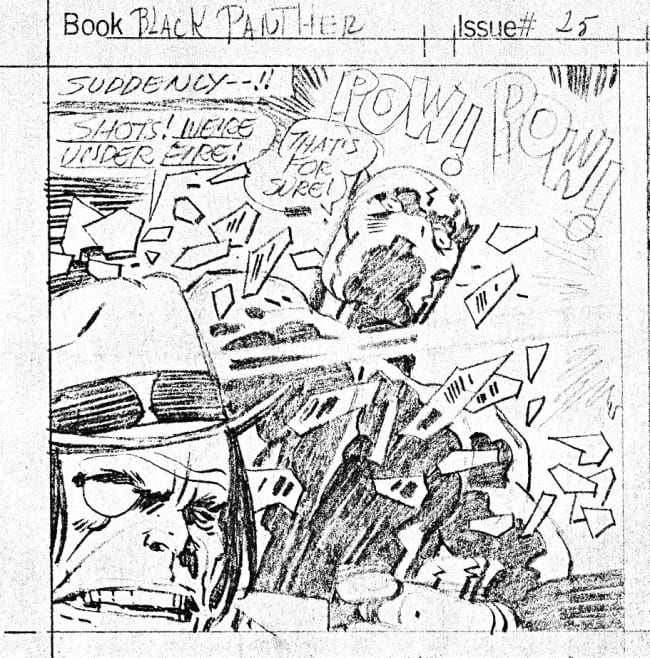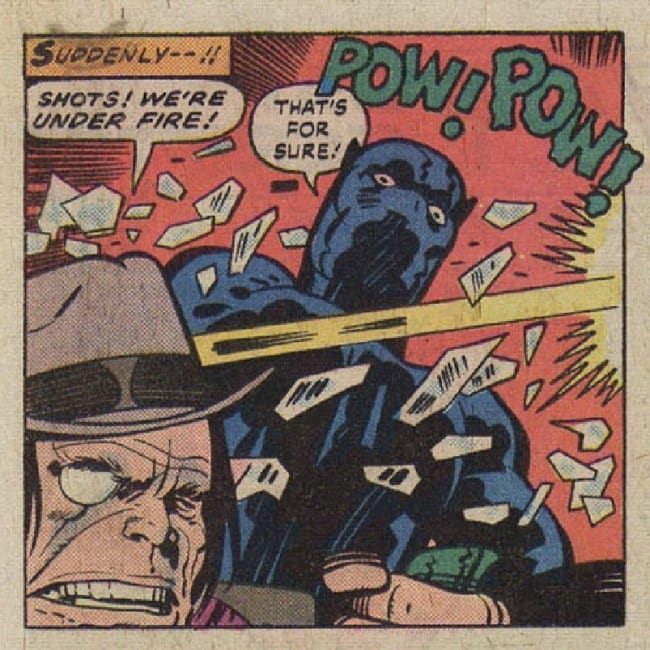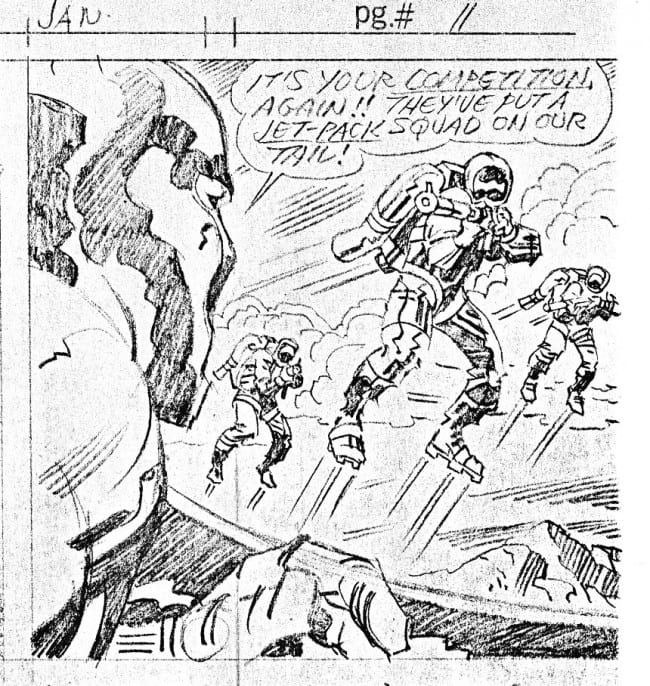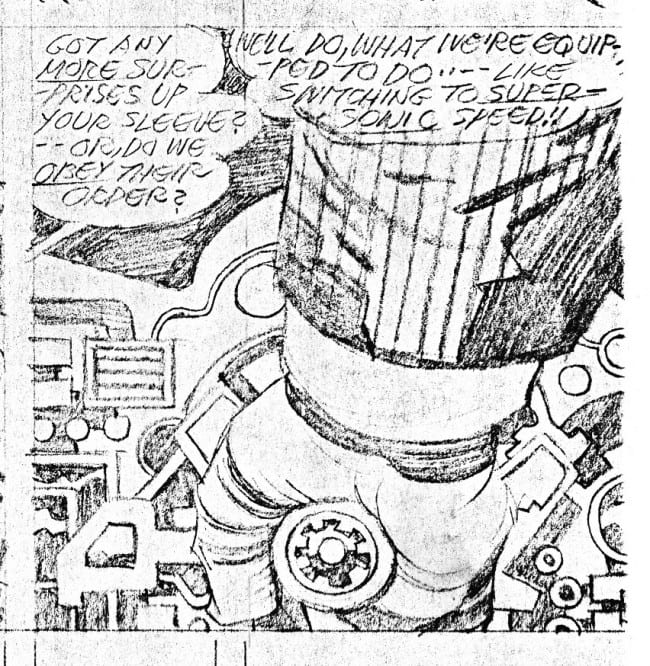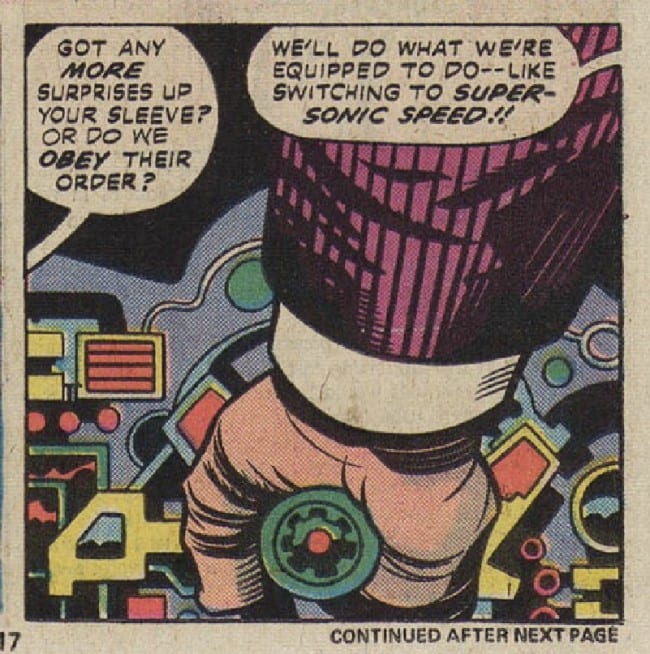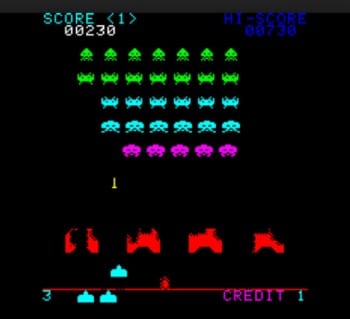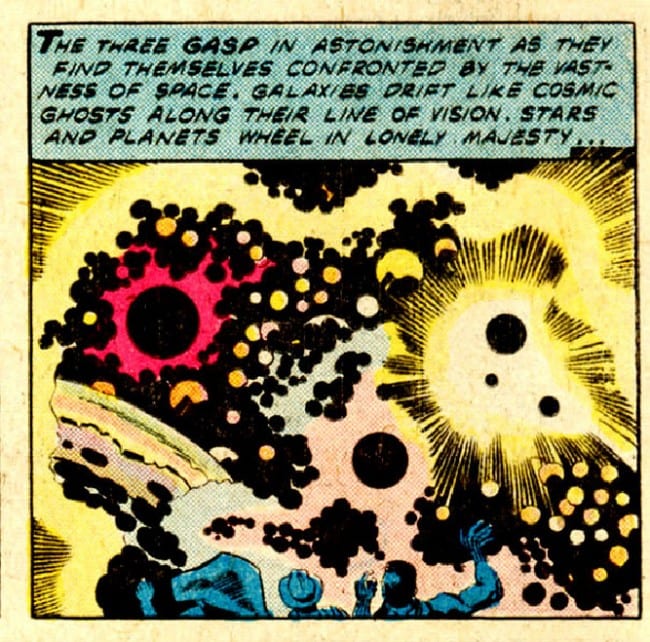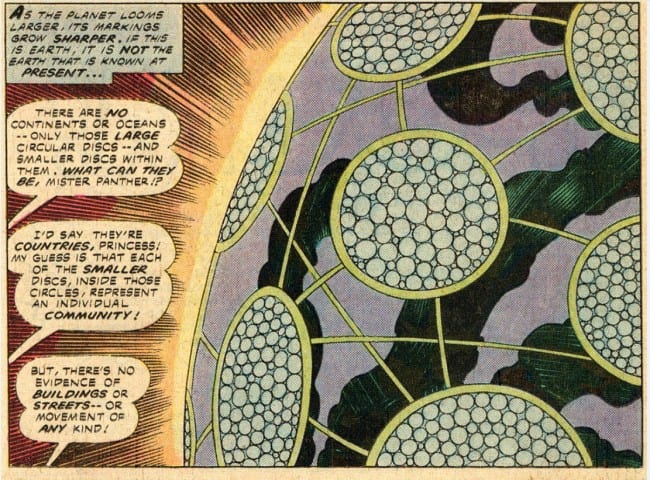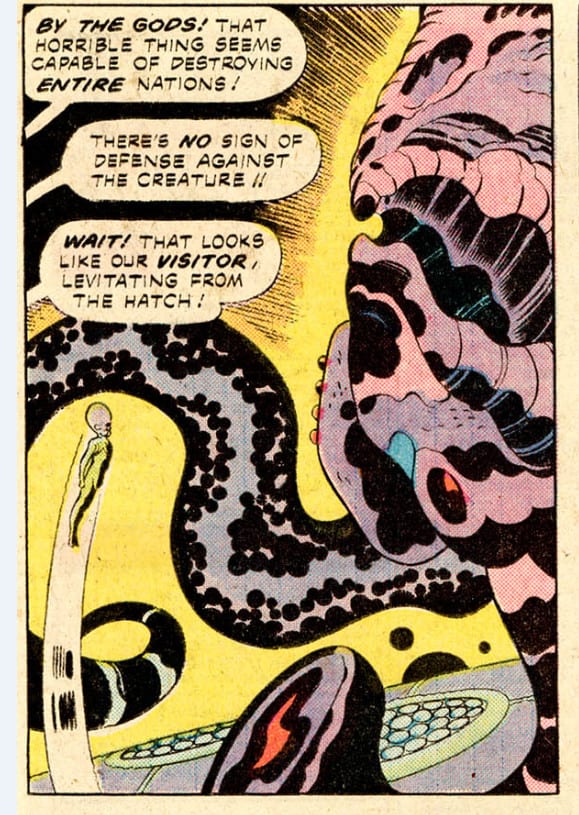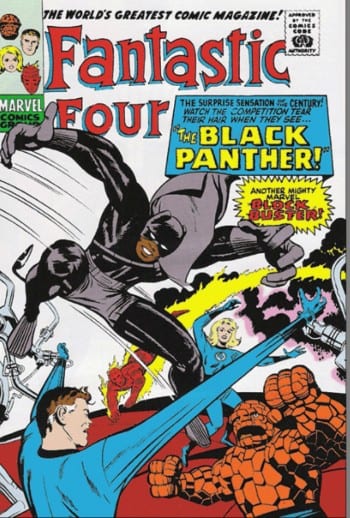The main reason I started studying Jack’s work in the early 2000s was because I was fascinated by what I call the Kirby/Lee authorship debate and the Kirby/Lee creation debate: who wrote the 60s stories Jack illustrated, and who created that endless parade of new, innovative Marvel characters? Including all the interviews and analysis from the previous decades, I think we can learn a lot from comparing Jack’s '60s illustrations and margin notes to Lee’s text, but I don’t want that kind of investigation to become boring so even though we might not necessarily learn a lot historically from scrutinizing today’s material, let’s take a look at some of Jack’s pencil-work from the 1970s and compare the art to the published product. Thanks to the Jack Kirby Museum Digital Archive Project for providing the pencil scans.
Because it’s probably one of Jack’s most unappreciated and underrated titles, I thought it might be fun to take a look at one of his Black Panther stories. Let’s check out the first issue from his 70s run. I don’t want to get too much into the Kirby/Lee creator debate on this one, but before we begin I do think it’s worth mentioning that Lee dropped a bombshell in his recent With Great Power documentary (2012). Here is a link to the video: "Stan Lee: I Created The Black Panther.” Obviously we could discuss this clip at length, but for now I just want to throw out this question: if Stan Lee decided to create the first black superhero in Fantastic Four # 52 (Jul 1966), where does Jack’s 1966 (or earlier) design for the Coal Tiger fit into that historical narrative? Here is a scan of the original art.
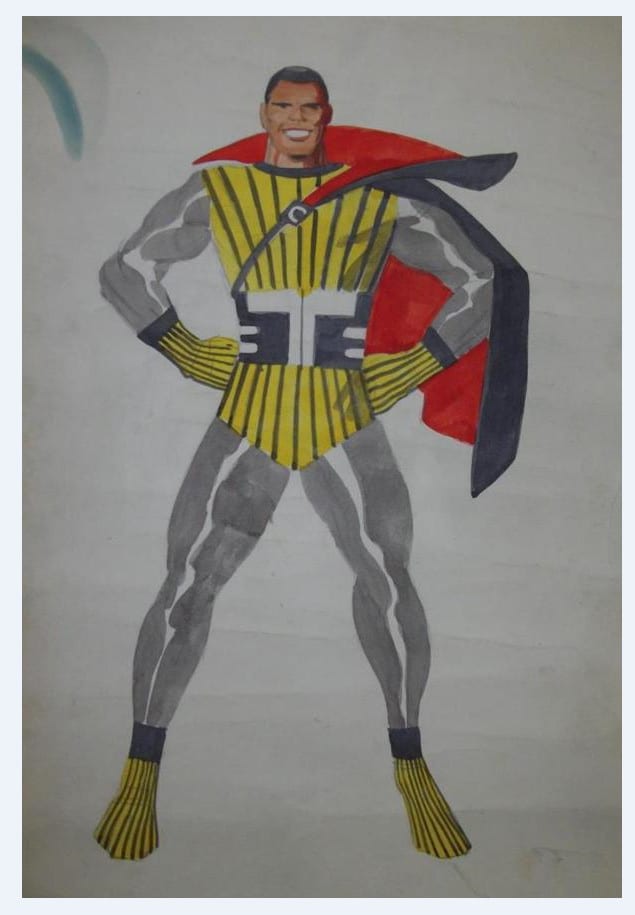 Doesn’t that image of the Coal Tiger suggest that at the very least Jack was heavily involved in the creation process leading to Black Panther? I’ll touch on that query a bit at the end of the article but for now, mercifully, I can do an article where there is no Kirby/Lee authorship debate. I think most comics historians and fans agree -- Jack Kirby wrote Black Panther # 1 (Jan 1977). Ideally, I could show you the whole book here, but I want to be respectful of Marvel’s copyright so I’ll verbally go through the story and pick 3 pencil pages that we’ll compare to the published work inked by Mike Royer. First, here’s the cover: not one of Jack’s most iconic, it’s a bit jam-packed, but it does give you a synopsis of the story which is what many great covers do.
Doesn’t that image of the Coal Tiger suggest that at the very least Jack was heavily involved in the creation process leading to Black Panther? I’ll touch on that query a bit at the end of the article but for now, mercifully, I can do an article where there is no Kirby/Lee authorship debate. I think most comics historians and fans agree -- Jack Kirby wrote Black Panther # 1 (Jan 1977). Ideally, I could show you the whole book here, but I want to be respectful of Marvel’s copyright so I’ll verbally go through the story and pick 3 pencil pages that we’ll compare to the published work inked by Mike Royer. First, here’s the cover: not one of Jack’s most iconic, it’s a bit jam-packed, but it does give you a synopsis of the story which is what many great covers do.
Examining the image closely, it’s wonderful how Jack uses an invisible grid structure to tell you a quick story with one image – going from left to right, top to bottom, you can see how the visual narrative proceeds: the Princess in the left aiming her gun at the Panther and reaching for him; your eye can follow the visual information across the page to the thug strangling T'Challa; Mister Little has a gun on the right, then in the foreground we see the Panther’s hands with the cracking cosmic frog as the centerpiece.
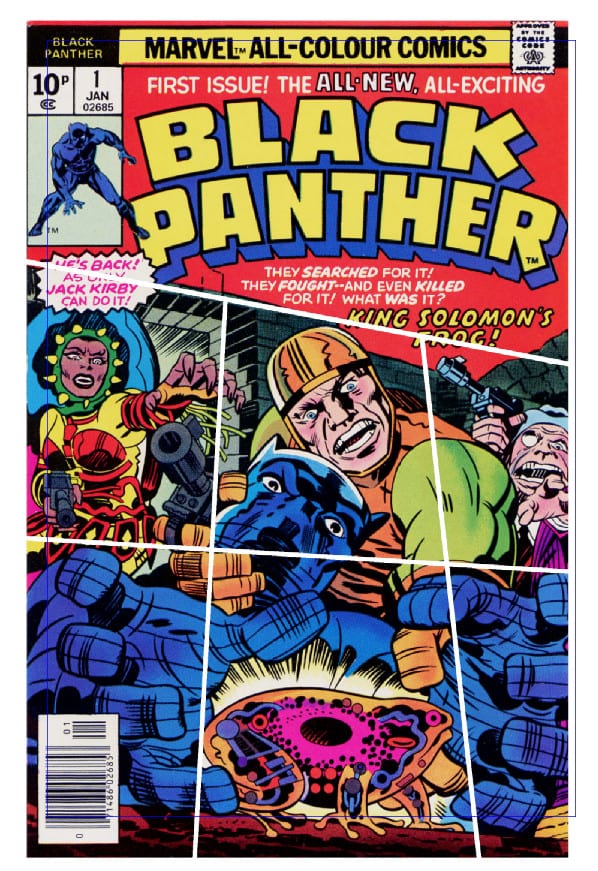 Nice to see the blurb on the cover: “He’s back as only Jack Kirby can do it!”
Nice to see the blurb on the cover: “He’s back as only Jack Kirby can do it!”
Here’s how the story begins:
Kirby’s text: “There have been objects throughout the course of history which have been sought after, fought over, and died for – but never was there such an artifact fought over as this of burnished brass! Mysterious and little known, it was the center of many strange and unexpected happenings! Now the Black Panther has answered its call! Will he fall victim to King Solomon’s Frog!”
On the splash, the Panther walks into a room, followed by the little character with a derby hat from the cover. In the foreground we see a man with a comatose expression holding a brass frog. When you turn the page, you see a full-size image of an enormous, ominous armored swordsman with half-moon shaped horns on his helmet, hiding behind a wall, ready to strike at the Black Panther who has his back turned to him. The Panther announces the old man with the frog is dead.
Here is the image of that two-page spread from another website: notice the wonderful background imagery. A myriad of ancient artifacts – they all must be extraterrestrial since they don’t look like they were designed in any ancient style I’m aware of, but in reality this is how Jack loved to portray ancient art – he made it up on the fly using his own sensibilities based on his knowledge of modern and ancient art. The little guy, which I’ll call a dwarf (although some may say that’s not politically correct) callously rips the frog from the cold dead hands of Mr. Queely.
On page three we learn the dwarf’s name is Mister Little. He creepily caresses the frog and proclaims Mr. Queely’s death was a result of the power of the frog. Mr. Queely is another character Marvel can exploit (they just need to resurrect him). In the next panel, the Panther playing the role of a detective points out the stab wound is fresh. Mister Little is convinced the cause of death was the brass frog. In the foreground we see the armored warrior begin to swing his sword towards the helpless Panther. Jack’s text: “At that moment the Panther’s sharpened instincts react to a sense of sudden danger – and save him from the fate that claimed Queely.”
In the past I’ve discussed Lee STO (Lee text based on Jack’s story/art that states the obvious), so if Kirby uses the same technique at times, I won’t be surprised because that is a solid method for keeping a story based on action simple and uncluttered, but here I wouldn’t call this Kirby STO because the idea that the Panther’s heightened cat-like instincts warned him of the danger is a new story element not in the art. So here we have a great marriage of caption and image, we learn something new from the caption, then we can enjoy the action. That’s masterful comics storytelling.
I won’t go through every line of text and every single story element, so continuing along: in panel 4 we see the sword chopping through a table, the Panther leaps away and warns Mister Little to flee. The next two panels are typical Kirby action: the swordsman barely misses the Panther’s head, then to quote Jack’s caption in the next panel, “… with cobra-speed, the Panther strikes back.” Here is the pencil art and published art of page 5 and close-ups of each panel. I’ll show them uninterrupted and you can read them if you choose.
Black Panther # 1, page 5
Black Panther # 1, page 5, panel 1
Black Panther # 1, page 5, panel 2
Black Panther # 1, page 5, panel 3
Black Panther # 1, page 5, panel 4
Black Panther # 1, page 5, panel 5
A couple observations: first, notice in page 5, panel 1, Jack’s original text for the Panther says: “If I don’t put this dude out of action now, we’re both chopped liver!” The published version clearly was edited (you can see the text is a bit different) and it says, “If I don’t put this killer out of action now, we may both yet die!”
Now I’m gonna be honest with you (and I know the hardcore Kirby Purists are going to hate me) I actually prefer the edited version, it makes the Panther sound a bit more generic which works for me for whatever reason. I can hear Jack’s critics out there chuckling about the chopped liver remark, but I enjoy having the chance to read Jack’s original text and I think it's fine. Okay, maybe the line is a bit wacky, but that’s Kirby. Every writer has a different voice and a unique style. This is dialogue written by a guy who was in his late-fifties, who grew up on the Lower East Side, survived the Depression, fought in the war, spent most of his life at a drawing board silently creating comics, doing dialogue for an African superhero in the '70s. Of course the text might be a little goofball at times. People forget how weird the 1970s was. Yeah, I think some of Jack’s text can be a bit dated or silly, but historically speaking -- for this book, it’s fun, wild and crazy, '70s comics. I can see why an editor (maybe Archie Goodwin) changed Jack’s text there, but I enjoy reading the original version. You gotta love an African King transplanted in America making a chopped liver reference. It’s Kirby. You either like it or you don’t. I know people who love country music and despise rap music. I know people who love rap music and despise country music. People have different tastes. I’ll take Jack’s chopped liver.
There’s another change to the text on page 5, panel 5: Jack’s original text for the Panther says: “With those iron threads and that sword he’s a perfect suspect.” The published version says: “With that iron suit and that sword, he’ll be easy to spot.” So was Jack trying to throw some urban slang in there calling the costume “threads,” or is this Jack just using a term he was familiar with from growing up? Maybe Jack’s trying to create his own kind of '70s slang for the Panther? You could argue the term is dated, or even stereotypical, regardless, whoever edited this material made a change and once again, the Panther comes off as a bit more generic. I also think that Jack’s text where the Panther calls the swordsman a “suspect” continues the theme from earlier in the story that the Panther is a kind of detective, investigating a crime. So there was really no need to edit that out. At the very least we can see that Jack’s work is being filtered through another set of hands and changes are being made, but I think storywise these are very minor.
On the next page Mister Little reveals that the swordsman was “a warrior plucked from antiquity and transplanted into this century.” Mr. Little says the frog used to belong to Black Panther’s grandfather – Azzari, The Wise (another new Kirby creation) and the little frog is actually a time machine. Mr. Little gives the Panther a small microscope so that he can examine the device in detail. You can see it is charged with swirling energy. I wonder if Jack’s depiction of the little cosmic frog was influenced by Mexican Tonala and Talavera artwork, he probably would have been exposed to that after his move to California.
Black Panther # 1, page 6, panel 6
Here's three Mexican Tonala frogs, and three Talavera. Images downloaded via Google images.
Was Jack influenced by Central and South American art, or is this visual approach towards the electrified time travel frog just another natural step in Jack’s progression as an artist. Here’s an extraordinary image from the 2001: A Space Odyssey series, issue # 2 (Jan 1977) where Jack uses a similar technique to show a character having her mind blown by the Clarke/Kurbirck monolith. In addition to Jack’s famous Kirby crackle, Kirby squiggles, and Kirby debris, you could add this type of swirling Kirby cosmic energy to the mix of weapons in Jack’s artistic arsenal.
On the next page, the Panther and Mister Little report the murder and leap into Mister Little’s golden helicopter parked outside. Before it creates more mischief, Mr. Little tells the Panther the brass frog must be returned to King Solomon’s ancient burial chamber. The Panther replies, “You’ve gone crazy Mister Little, an army of fools has died following that fairy tale! You may as well look for Camelot! Or the Lost Aztec city of gold!” Mister Little tells the Panther King Solomon was no myth, “he lived a fabulous life and accumulated fantastic treasures! The brass frog was among them.”
A giant enemy ship appears and pursues Mister Little’s copter. Huge doors open and attempt to suck the copter from the sky, but Mister Little fires missiles, blows the ship to smithereens then maneuvers his ship out of harm’s way. Mr. Little begins to tell the Panther the history of the frog time machine -- thieves plundering ancient ruins discovered it amongst other treasures and when disturbed, caused it to unleash a beast. Let’s take a look at Page 10. I’m sure you can read it without my narration.
Black Panther # 1, page 10
Black Panther # 1, page 10, panel 1
Black Panther # 1, page 10, panel 2
Black Panther # 1, page 10, panel 3
Black Panther # 1, page 10, panel 4
There’s a slight change to the text in the caption box in panel 1, the editor added “deemed” to the mix so the rest of the text had to be moved. You also have a minor change in panel 4, it looks like “century…” was changed to “century!”
The main reason I chose to show this page was to emphasize the sheer variety of concepts you would get in a Kirby book. We’ve already seen references to King Solomon’s mines, Aztec cities of gold, Camelot; now we get Ali Baba, Merlin, even the Loch Ness monster thrown in for good measure. Just amazing how Jack packs that kind of stuff into a 17-page story. You have to give Jack credit for one thing: he gave kids their money’s worth if they were looking for lots of characters and ideas. It’s also nice how in this first issue Jack firmly plants Black Panther smack dab in the middle of the history of mythology. Jack’s Panther is a new member of that mythos, a detective, an inventor, an archaeologist -- T'Challa is a superhero version of Indian Jones years before Spielberg would make Raiders of the Lost Ark (1981). And that kind of depiction of an extraordinary African character is something you did not see a lot of (if at all) in contemporary comics at that time. You didn’t really see those types of characters in any media except in the so-called Blaxploitation films. And that is something that I think makes Kirby’s '60s Black Panther and his '70s Black Panther special – this is not a Blaxploitation character, this is just a regular, run of the mill Kirby superhero who just so happens to have been born in Africa.
The last penciled page for this month is page 11. I thought it had some nice Kirby action, so here you go.
Black Panther # 1, page 11
Black Panther # 1, page 11, panel 1
Black Panther # 1, page 11, panel 2
Black Panther # 1, page 11, panel 3
Black Panther # 1, page 11, panel 4
Black Panther # 1, page 11, panel 5
The final panel is a bit anticlimactic for our purposes, but Jack can’t make every single image spectacular, sometimes it’s important to take a break from the action. I mainly love those flying jet packs, that’s a concept Jack used many times over the years, one memorable example being this legendary cover featuring Jack’s Nick Fury Agent of S.H.I.E.L.D character that has become so famous because of the Marvel movies. Strange Tales # 142 (Mar 1966). Mike Esposito inks.
I’ll briefly plow through the rest of the story: Mr. Little’s chopper blasts into warp speed and shoots like a comet to Mr. Little’s massive underground, subterranean complex where he has a museum full of ancient objects. A gunman emerges from the shadows and blasts Mister Little, who looks as if he’s been shot dead by the assassin. The Panther is furious and leaps into action fighting a squad of costumed goons. The battle is fierce, then a woman enters the scene and fires a weapon at the Panther knocking him out.
A quick aside: my computer over the last few years has been slowly invaded by malware and viruses, so as I’m writing this article, it’s like playing a video game -- I’m constantly fighting error messages, and restarting and reopening programs, shooting down obstacles like a kid playing the old Space Invaders video game in the arcade.
As I watch the Panther battling the bad guys on the screen, I’m fighting a technological battle with my own computer. It’s a war just to piece this article together. I’m not saying this to call attention to myself, just reflecting on how interacting with comics has changed. When I was 10-years old reading comics in 1977 -- hiking to the local 7-11 and kicking back in the back yard on a hot summer afternoon with a stack of four newsprint books for a buck was a lot different than sitting here on the couch with a wireless keyboard in my lap, zooming into the imagery on a widescreen TV hooked up to my PC. Just amazing how in a few short decades the way we interact with media and share media has changed astronomically. You have to wonder, do people ever just read anything anymore without clicking on lots of windows and dashing out comments. Anyway, back to the story:
We learn the Princess is named Zanda (yet another new Kirby creation) and she berates her guards. She’s a pretty stunning young lady. You can see the splash page here. It goes without saying that Jack did not draw in photorealistic style, his art was more expressionistic and abstract, but this is still a stunning pin-up.Here's Zanda after a wardrobe change sharing a tender moment with T'Challa from later in Jack's run in Black Panther #5 (Sep 1977).
My only criticism of Jack's text is all the stuttering. I know people talk like that when they're nervous, scared, or indecisive, but I don't think it reads well. Far be it for me to be so arrogant, but if I could ever have given Jack one piece of constructive criticism, I would have suggested he abandon that technique. And I'm sure Jack might have liked to work with an editor (or at least a trusted proofreader) who he could trust, but after his experience with Lee I doubt he wanted anyone else ever telling him what to do.
Moving along, the Princess takes the time-frog and says, “At last it’s mine! The doorway to time itself! Secure within this humble object.” We learn that in the tomb of King Solomon there is a control code that must be located in order to harness the power of the time-frog. The Princess and her men rough up the Panther, they want to know where the code is. The Panther is defiant, brave – he fights back, kicks the frog out of the Princess’ hands and grabs it. One of the gunmen blasts the frog out of the Panther’s hands, it lands on the ground then starts to glow. Jack’s text: “a glaring radiance fills the field of action – the doorway to time has opened once again! A tall vague man-like shape appears! A phantom from… where?”
On the final splash you have this awesome full-page image of an alien with a gigantic head that has the word “Hatch 22” tattooed on it’s forehead. The head almost fills the whole page. Not only do we have all the characters and concepts from the ancient legends and mythologies of mankind, now Kirby is throwing space aliens into the batch. Just remarkable stuff from the '70s -- remember, this book was only 17-pages long, and 6 of those pages (one a 2-page spread) are a single image! Amazing amount of material in this single book.
Jack’s text on this final page. Caption box: “When the blinding light fades, the time threshold has been closed… but the bizarre being who has stepped across the centuries now stands solid and alone – facing creatures as strange to him as he is to them.”
The alien screams, “What are you? Speak or die!”
The Panther exclaims, “By the great lion! The brass frog’s hit the jackpot this time!”
The final caption box says: “If you think our past has been stormy – wait’ll you see what’s come from the future! Next: The Six Million Year Man! Don’t Miss Him!”
It looks like some of that text was edited. The Kirby Museum does have this whole book in pencil form, I only got to look at the three pages above so maybe a future comics student can compare the pencil work to the published book, it would be interesting to see if the changes made any difference to the story or the characters. And of course it goes without saying, the alien is yet another new Kirby creation. To me, this is a terrific cliffhanger. I would definitely have wanted to find the next issue after reading this when I was a kid.
Looking at the TwoMorrows Jack Kirby Checklist (1998), it looks like Jack may not have made photocopies of the pencils for Black Panther # 2 (Feb 1977), so since we may never be able to compare the published book to the pencils, I figure I’ll throw in a few images from that book. I'll pick a baker's dozen. I won’t give any commentary, except to say clearly Kirby was going cosmic at this point. Despite being a pretty terrestrial character, in Jack’s hands during this era of his career, the Black Panther becomes a celestial space-time traveler. I’ll show some of the more spectacular images, probably a big departure from where other writers/artists had taken the Black Panther character during Jack’s absence. As you can see, Mister Little survives, and despite the antagonistic relationship, Princess Zanda becomes an ally.
Images from Black Panther # 2
I don’t recall ever even seeing a Kirby Black Panther book on the newsstands, but reading this now, it’s amazing how it brings back the memory of how much fun it was reading comics in the late 1970s. This stuff was such a joy to find at the local drug store, yard sale or flea market, especially when you consider there was no cable TV or video games yet. Ironically, I didn’t even really like Kirby’s work when I was a kid. It was too weird for me. Now I enjoy reflecting on how lucky I was to have a handful of those old weird Kirby comics with all the polka dots pouring out of them like radiation.
Getting back to the Black Panther character, earlier I mentioned in his 2012 documentary With Great Power produced by his own POW entertainment company, Stan Lee claimed he decided to create the first black superhero in 1966. History is written by the victors and Lee outlived Jack, so in all likelihood future generations will credit Stan Lee as the creator of the first major black American superhero in 1966. And that's fine. Lee was involved. But here’s my theory: based on my research, briefly, I think in the late 1960s Kirby had a mountain of ideas for new characters. You see them pouring out of all his books during that period. He was also starting to formulate his Fourth World mythos. Jack hoped Lee might let him spin some of these ideas off into new books where he would be allowed to add the text to the stories. The Inhumans storyline is probably a good example of this -- Jack could have handed FF off to another artist, and he could have explored a new team of characters on his own, that way Lee could still have the prestige of being the “writer” on a book like FF. I suspect Black Panther is another idea Jack would have loved to explore.
It looks to me that Coal Tiger was a Kirby creation -- Jack probably presented the idea to Lee knowing there were no other major black superheroes at that time, so since it was relatively unprecedented it would require some discussion before getting the green light. In other words, maybe Jack felt he had to run a black character by Lee before introducing the character in the FF storyline; Lee admitted Jack would do that with characters like Silver Surfer -- Lee says in his Origins of Marvel Comics book (1976) he never saw Silver Surfer until Jack turned in his story. Maybe Jack was passionate about introducing a black character into his pantheon of characters, so he drew up Coal Tiger and pitched it to Lee. Here is the published version of Jack’s presentation piece with text added.
It wouldn’t shock me if Lee had a problem with the Coal Tiger name. It is a bit problematic, I think. I don’t know how well that would have flown then, or now, but who knows -- if Jack had pulled it off, the Coal Tiger character today might be an icon. We’ll never know for sure who came up with the idea for calling the character Black Panther. One thing is for sure, Jack designed the Coal Tiger costume, then he designed the Black Panther costume. Based on this rejected Fantastic Four # 52 (Jul 1966) cover, it appears Lee had him cover the whole face. Baffling why Lee would reject that cover; it must have driven Jack nuts since he didn't get paid for rejected work.
You can see most of Jack's original Coal Tiger costume elements are there, the new costume is just black and no "t." Then in the book itself, you have to think there is a very good chance Jack was the one who built the T'Challa character from the ground up when he wrote the story with visuals and margin notes. Jack probably came up with the nuts and bolts of the origin and all the things that made the Black Panther a unique stand-alone character.
But obviously that’s all pure speculation, all I can ask is that when a future comics historian or a documentary filmmaker discusses the history of Marvel and something like the Black Panther character, when you show the video clip from With Great Power of Stan Lee claiming he created the first black superhero without any mention of Kirby, just please show the Coal Tiger pitch and point out that not only was Jack probably heavily involved in the creation of that character, it may have been his idea. All I ask for is some balance.
And if Kirby did come up with the idea of creating the first significant black superhero, I’m not claiming that means he was the Martin Luther King of comics, just pointing out you could argue Black Panther was the Jackie Robinson of comics, and Kirby may have consciously put forth the idea that anyone can be a superhero regardless of ethnicity. Jack would continue to create diverse characters throughout his career: a couple great examples being the Native American character Wyatt Wingfoot in FF, and the Asian Sonny Sumo in Forever People. Wyatt Wingfoot is a particular favorite of mine not only because of my love for Native American culture, but he's a real (fictional) person -- no superpower from a radioactive bomb or bug bite.
To wrap up this month’s column, reflecting on Jack's service to his country in WW II, let’s look at this 2-page spread from a relatively famous story (in comics history circles) from Our Fighting Forces # 159 (sep 1975) featuring Mile-a-Minute Jones, a character in all likelihood based on Jesse Owens. You can actually see the entire 17-page story here: "Social History in Comics: Our Fighting Forces 159 - Mile-a-Minute Jones!"
Another example of Jack seamlessly integrating a black character into a story. It doesn’t seem forced. It doesn’t seem like Jack’s just trying to be PC. It’s a sincere story that’s not only about race, it’s a story about heroism and humanity. As far as I know, these types of stories were not common in comic books even as late as the 1970s, and if you were going to examine the history of African American characters in the comics medium, I think a story like this is worth mentioning. Kirby was quietly integrating comics with little to no fanfare. I think the reason Jack produced a story like this is because he probably felt all men are created equal based on growing up surrounded by different cultures in New York; he genuinely wanted to be progressive on race relations; and quite frankly, Jack had the power to do a story like this. He didn’t have to worry about some editor nixing the idea because it might not sell.
As many of you probably know, Jack also introduced a black GI in Sgt. Fury and his Howling Commandoes # 1 (May 1963) -- Gabe "Gabriel" Jones. Funny that the character is colored white in this original printing of the first issue.
As editor, and famous for his micro-management after he received Jack's penciled stories, it’s incredible Stan would have missed something like that. Maybe it's possible Lee didn’t even know the character was black until Jack pointed it out to him later? Also interesting to see when that was corrected Lee and the colorist gave him a kind of grey color, almost olive. This is Gabe Jones in action from Sgt. Fury # 7.
As early as 1963 it would seem Jack felt it was important to make his archetypal version of an American WWII fighting unit a realistic reflection of the American population. This kind of multiculturalism may have also been an echo of Jack’s own experience in the Second World War, fighting side by side with Americans from all corners of the nation, making life-long friendships with men and women regardless of skin color or cultural background. Although not an iconic superhero worth billions of dollars like Spider-Man, you could argue Gabe Jones is another important character in the history of the comics medium -- he represents a step forward in the same way a character like Lieutenant Uhura in Gene Roddenberry’s revolutionary Star Trek television series (1966-69) expressed the idea that all human nationalities and ethnicities are equals in the future (obviously there were problems with the Klingons). There is no talk of Uhura’s race in Star Trek. She is an equal. There is no talk of Gabe Jones’ race in the Nick Fury books. He is an equal. One of Jack’s associates, artist John Severin recalled that in the 1950s Jack pitched him the concept for a syndicated comic featuring a straight talkin’, cigar chompin’ Sergeant leading a diverse group of wild and wacky GIs – an adult version of the Simon/Kirby Boy Commandoes. So as early as the 1950s, Jack may have already been making plans to promote ethnic and cultural diversity in comics.


